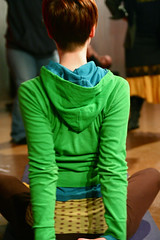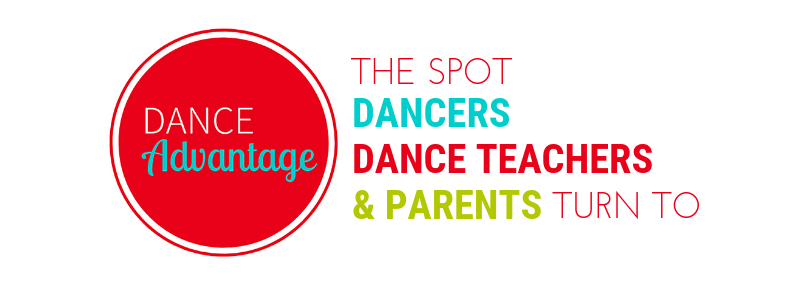Is stretching part of your ritual?

While I was a dance major, I had a very strict routine that consisted of getting up at 6:00am, making coffee in my leotard, driving to school by 7:30am (to grab my super secret parking space in downtown Chicago), and entering the studio for morning ballet class before anyone else had arrived. The sun would peak through the windows creating a beautiful, peaceful place for me to be alone without the distraction of other dancers, teachers or fluorescent lights.
Five days out the week I followed this routine, and without fail the first thing I would do is lay down on the ground, stick my feet over my head and stretch.
I never gave much thought at that time as to whether or not stretching before class was beneficial. It is just something we dancers do. We arrive early (never on time) and stretch. Many ballet teachers give a warm-up or stretching exercises to the class before even beginning the barre. I remember being told as a young dancer “you must be fully warm before you ever do your first plie.” You feel that morning crunchiness in your joints, the little tug in your hamstrings, and just “stretch it out.”
To stretch or not to stretch?
The idea of stretching before physical activity is not unique to dance. I recall those days of P.E. where we would all stand and stretch together before going to play whatever sport was featured that day. In fact, studies performed as recently as 1989 have declared stretching to be “essential” in preventing injury and enhancing performance by increasing the elasticity and range of motion (ROM) of the muscle (1). It is by this presumption that we came to believe that you must stretch before completing any sort of vigorous physical activity, and this opinion is still held by a great many P.E. and dance teachers, not to mention personal trainers, physical therapists, sports physicians and athletic coaches (2).
More recent research has questioned the commonly held belief that stretching before activity is beneficial to performance and prevents injury. In fact, there is some evidence to suggest that stretching can have detrimental effects on performance, and may even INCREASE the risk of injury…
But aren’t there different ways to stretch?
There are five major types of stretching: static, dynamic, proprioceptive neuromuscular facilitation, ballistic stretching, and eccentric lengthening. For the purpose of this article, we can work with the two most common forms of stretching (static and dynamic). You may see both types in your dance classes or do them on your own. The other types of stretching are usually employed in a therapeutic setting with the help of a clinician. Here’s a summary of the difference between the two types:
STATIC STRETCHING
 Now, let’s assume that you aren’t lucky enough to be one of those hyper-flexible Gumbi-type dancers that can walk into a studio cold and plop down into the splits. That is a whole other issue that carries its own set of benefits and challenges. Instead, you are a dancer of average flexibility. You have no problem extending to 90-degrees, and once you are warm you can easily accomplish the splits and higher extensions. However, when you first enter the studio, you feel that pinch and that crunch. In the traditional thinking, you are like me: the dancer who comes in early to sit on the floor in a straddle, or plow, or forward bend until the pinch slowly begins to ease and feel less pinch-y. This type of stretch is called static—where you choose a position at the end of your ROM (range of motion) that targets a particular muscle, and hold it.
Now, let’s assume that you aren’t lucky enough to be one of those hyper-flexible Gumbi-type dancers that can walk into a studio cold and plop down into the splits. That is a whole other issue that carries its own set of benefits and challenges. Instead, you are a dancer of average flexibility. You have no problem extending to 90-degrees, and once you are warm you can easily accomplish the splits and higher extensions. However, when you first enter the studio, you feel that pinch and that crunch. In the traditional thinking, you are like me: the dancer who comes in early to sit on the floor in a straddle, or plow, or forward bend until the pinch slowly begins to ease and feel less pinch-y. This type of stretch is called static—where you choose a position at the end of your ROM (range of motion) that targets a particular muscle, and hold it.
DYNAMIC STRETCHING
Dynamic stretching is a series of or active motions that increase joint ROM and stretch the muscles more passively than static stretches. Examples include leg swings (or balancoire), grand battement, and arm swings. Some people believe that this is a more natural way to stretch and increase your range of motion, and it simultaneously warms the body. Dynamic stretching is rather trendy right now because it somehow fulfills our moral obligation to stretch and isn’t uncomfortable like static stretching.
So, can I stretch before class, or can’t I?
That depends on the goal…
If you are stretching with the goal of long-term changes in your flexibility (for example, you can’t do the splits and would like to), save your stretching routine for after class or between barre and center when your muscles are “warm.” See more about this in Nichelle’s post about Stretching Safely For Splits.
Generally speaking, both of the stretching techniques above have acute (short-lasting) effects on your range of motion before activity, but don’t really increase your overall flexibility.
If you are stretching to chase away the “crunchiness,” there isn’t really any reason to believe that stretching before class can hurt you, but then again, it doesn’t necessarily help you either. Stretching doesn’t inevitably mean that you will not be sore or will be less sore (3). Some researches have found that pre-stretching might result in a small decrease in muscular strength and power, and this may be of importance to elite dancers requiring exceptional strength and endurance, but there is no current evidence suggesting that stretching while cold leads to injury (3,4).

- Image by stevendepolo via Flickr
Bottom line:
Ultimately, if stretching feels good, then stretch. If it’s part of your morning routine or class-time ritual, then do it. Just take care…
- Stretching should never hurt.
- Don’t reach past your natural range of motion unless your body is completely warm.
- If you find that static stretching is very uncomfortable for you, try some dynamic stretches.
Your body is a complex series of chemical and mechanical processes, and while we imagine that muscles are as simple as stretching a rubber band, there is a lot going on in there that is still not fully understood by scientists. But for more on muscles, you’ll have to wait!
Want to know more about how muscles work? See Muscles 101.
References:
- Safran, M.R., A.V. Seaber, and W.E. Garrett, Jr., Warm-up and muscular injury prevention. An update. Sports Med, 1989. 8(4): p. 239-49.
- Shehab, R., et al., Pre-exercise stretching and sports related injuries: knowledge, attitudes and practices. Clin J Sport Med, 2006. 16(3): p. 228-31.
- Herbert, R.D. and M. Gabriel, Effects of stretching before and after exercising on muscle soreness and risk of injury: systematic review. Bmj, 2002. 325(7362): p. 468.
- Thacker, S.B., et al., The impact of stretching on sports injury risk: a systematic review of the literature. Med Sci Sports Exerc, 2004. 36(3): p. 371-8.
Lauren Warnecke is a freelance writer and editor, focused on dance and cultural criticism in Chicago and across the Midwest. Lauren is the dance critic for the Chicago Tribune, editor of See Chicago Dance, and founder/editor of Art Intercepts, with bylines in Chicago Magazine, Milwaukee Magazine, St. Louis Magazine and Dance Media publications, among others. Holding degrees in dance and kinesiology, Lauren is an instructor of dance and exercise science at Loyola University Chicago. Read Lauren’s posts.


